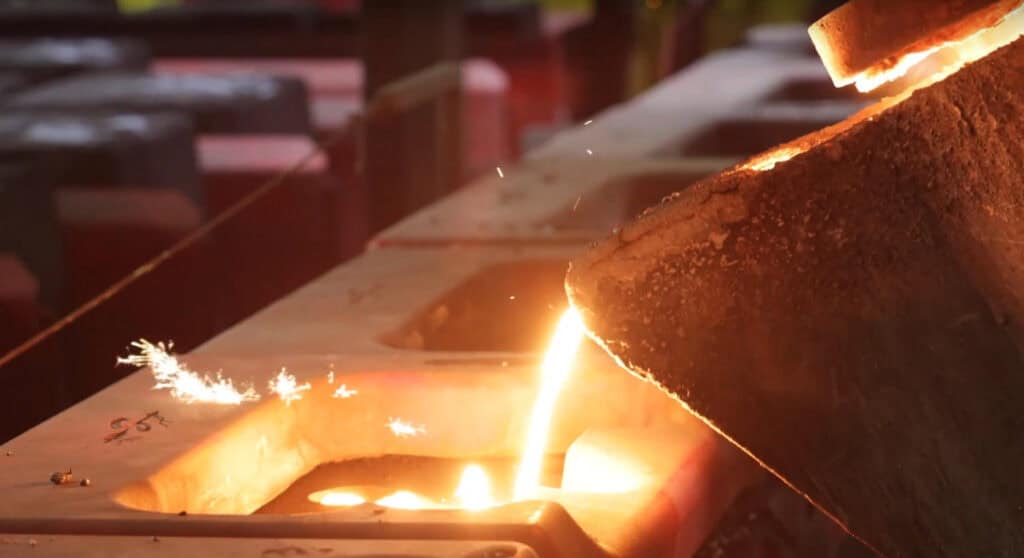What is a Foundry?
Foundries are manufacturing facilities where metal castings are produced. Molten metal is poured into a mold and cooled to create a finished product in the desired shape. Foundries have existed for centuries and were at the forefront of technological advancement during periods such as the Industrial Revolution.
Today, the foundry industry is vital to our society’s manufacturing backbone. Metalcasting facilities make many essential consumer products and parts, such as automotive and aerospace parts, pipe components, tools, cookware, and more. In fact, according to the American Foundry Society, 90% of all manufactured goods contain metal castings.
Types of Foundries
Ferrous Foundries
Ferrous foundries work with ferrous metals, magnetic metals known for their strength and durability. The most common types of ferrous metal alloys are steel and iron. Ferrous metals are frequently used in the automotive and construction industries to produce more durable parts that endure harsh conditions. Cast iron pans are an everyday example of ferrous foundry work.
Non-Ferrous Foundries
Non-ferrous foundries work with non-ferrous metals like aluminum, bronze, copper, and titanium. Although non-ferrous metals are less durable than iron and steel, they’re much more resistant to corrosion and rust than ferrous metals. Their lower durability also has the added benefit of a lower melting point and greater malleability than ferrous metals.
The Foundry and Metalcasting Process: Overview
While there are various casting methods, most of them use a mold and follow a similar step-by-step process.
Patternmaking: This is the process of making the exterior pattern of a casting. It is the most critical part of the process because if exact dimensional accuracy isn’t met, the final castings won’t fit together as intended.
Coremaking: If the casting design has a hollow core, an additional piece of sand or metal (known as the ‘core’) shapes the internal dimensions of the casting to make it hollow. Cores are designed to be sturdy but easy to break down or condense so they can easily be removed from the final casting.
Molding: A material, such as green sand, is tightly packed into the mold around the casting pattern. The pattern is removed to fill the hollowed-out mold with molten metal.
Melting & Pouring: Scrap metal, alloys, and other metals are charged into a furnace. The metals are then melted within the furnace and moved for pouring, which is then poured into the mold cavity to fill it with molten metal.
Cooling & Finishing: The molten metal is left in the mold cavity to cool and harden. The mold is removed, and the casting is trimmed and polished, leaving a clean, finished casting.
Casting Methods
Despite foundry processes being similar in some ways, most foundries vary by the method they use to produce castings. There are many different ways castings can be made, including:
Sand casting: The most common casting method used by metalcasting facilities, sand casting involves creating molds made from wet sand. It is popular because it is cheap and efficient compared to other types of casting.
Die casting: High pressure inserts Molten metal into a mold cavity. The mold is created using tool steel dies. Die casting tooling is expensive but excellent for high-volume casting production and working with non-ferrous metals such as aluminum.
Investment casting: Investment casting uses wax patterns to shape a ceramic mold for casting purposes. The wax molds in investment casting are disposable, whereas die casting molds can be reused. Investment casting is highly accurate, so it’s often used for applications requiring precise dimensional accuracy, such as medical equipment and small aerospace parts.
Lost foam: Lost foam casting is a newer casting method that functions similarly to investment casting. The pattern is made from foam instead of wax, and the molten metal evaporates the foam as it fills the mold, taking on the desired casting shape in its place.
No bake: Another popular casting method, no bake casting, involves mixing a liquid chemical binder with sand and then leaving the mixture to harden and cool at room temperature to create a finished casting.
GK Foundry Systems
Foundries are an essential part of our economy, developing castings for industries ranging from automotive and aerospace to medical. They rely on precise processes, such as patternmaking, molding, and various casting methods, to produce high-quality products that keep our world running. Contact us to learn how GK Systems can help you build an efficient turnkey foundry system.
